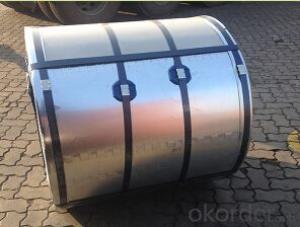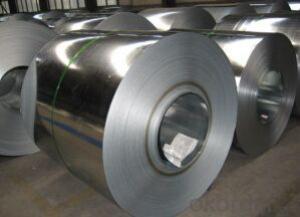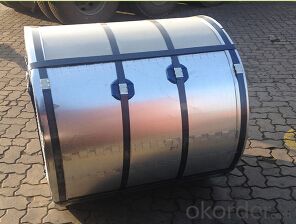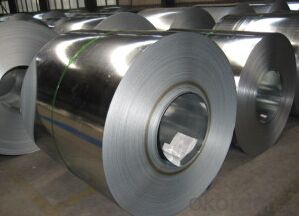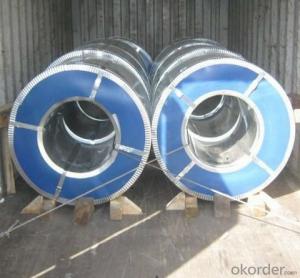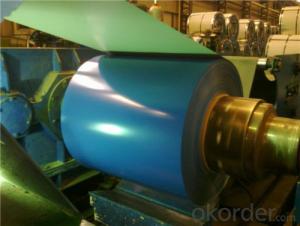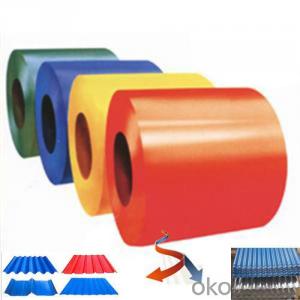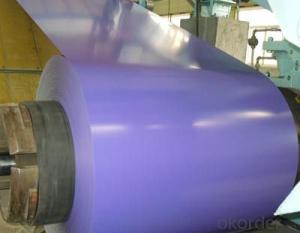Zincalum Rolled Steel Coil for Construction
- Loading Port:
- Tianjin
- Payment Terms:
- TT OR LC
- Min Order Qty:
- 25 m.t.
- Supply Capability:
- 10000 m.t./month
OKorder Service Pledge
OKorder Financial Service
You Might Also Like
Zincalum Rolled Steel Coi application:
Surface Treatment:Coated
Technique:Cold Rolled
Standard:JIS
Steel Grade:Q195
Width:914, 1000, 1200, 1219, 1220, 1250
Grade:Dx51d / Dx52d/ Dx53D/ S250,280,320gd
Base Material:Galvanized or Gavalume
Treatment:Galvanized or Prepainted
Color:Ral Standard, or Buyer′s Sample Color
Thickness:0.14mm to 1.5mm
Zinc Coating:40-150GSM
Length:up to The Thickness
Material:Steel
Lacquer:Top Side15-25 Micro,Back Side 5 Micro
Export Markets:Global
Trademark:STW
Packing:Sea Worthy Packing
Standard:0.2mm to 1.2mm
Origin:China
HS Code:72103000
Production Capacity:10000 Tons Per Month
Specifications;
1. Aluzinc coating mass: 30g-275g/sqm
2. Coil weight:4-6 tons per coil
3. Edge treatment: Mill edge or cut edge.
4. Technical treatment: Bright annealed, flatting, cold harden.
5. Surface treatment: Annealed, bright finish, dull/bright finish, slit edge.
6. Spangle: Normal/small/big/zero spangle.
7. Delivery terms: FOB / C&R / CIF
8. Supply Ability: 30000MT/month
9. Application: The construction industry: The roof structure, keel, grill, Clapboard, ceilings, fire shutter doors, etc; The light industry, the Automobile, agriculture, animal husbandry, fishery, casing of household Electronic application, civilian smoke stack, etc.
10. Delivery time: Within 30 days after the receipt of L/C or Signed the contract or according to customer's requirement.
Special design available according to requirement; Anti-corrosion And high-temperature resistant with black painting; All the production process Are made under the ISO9001: 2000 strictly
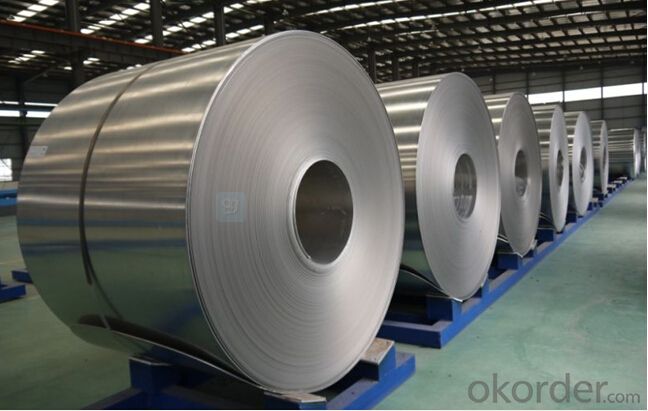
| Zinc Coating | 60-275g( as required) |
| Thickness Range | 0.14-1.5mm |
| Coil Inner Diameter | 508mm |
| Coil weight | 3-5MT(as required) |
| Surface | Regular/mini/zero spangle, chromated, skin pass, dry etc. |
| Width range | 600-1250mm(900mm, 1215mm, 1250mm, 1000mm the most common) |
| Applications | With excellent cold bending molded manufacturablity, good decoration effect, strong anti-corrosion ability, galvanized steel coils and sheets are also pollution-free and easily recycled. Accordingly, they can be used as final products and basic plates of color coated steel coils and widely applied in construction, home appliances, decoration, ect |
FAQ
1.What's your MOQ?
25MT, it is for one container.
2.Do you have QC teams?
Yeah, sure, our QC team is very important, they will keep the quality control for our products.
3. What's your normal delivery time?
Our delivery time about 10-20days for standard sizes, if you have other requirements like hardness and width ,it is about 20-40days. But don't worry ,we also try our best for the delivery time ,because time longer and our cost is higher.
4.Are the products tested before shipping?
Yes, all of our PPGI and GI was qualified before shipping. We test every batch every day.
- Q: What is the lifespan of steel coils?
- The lifespan of steel coils can vary depending on various factors such as the quality of the steel, the conditions in which they are stored or used, and the maintenance practices employed. However, with proper care and maintenance, steel coils can last for several decades or even longer.
- Q: What are the different types of coil edge trimming machines?
- There are several different types of coil edge trimming machines available in the market. These machines are specifically designed to trim the edges of coils or rolls of various materials such as metal, paper, plastic, or fabric. Each type of machine has its own unique features and capabilities, catering to different trimming requirements. 1. Manual Edge Trimmers: These machines are operated manually, where an operator manually feeds the coil and trims the edges using a cutting tool or blade. Manual edge trimmers are typically used for low volume trimming applications and require the operator's skill and precision. 2. Semi-automatic Edge Trimmers: These machines have automated feeding mechanisms that assist in feeding the coil through the machine. The trimming process is still performed manually by the operator using a cutting tool, but the feeding mechanism reduces manual effort and increases productivity. 3. Automatic Edge Trimmers: These machines are fully automated and require minimal operator intervention. They are equipped with advanced sensors and controls that enable precise and consistent trimming of coil edges. Automatic edge trimmers can handle high volumes of coils and are often integrated into production lines for continuous trimming operations. 4. Rotary Blade Edge Trimmers: These machines utilize rotary blades to trim the edges of coils. The rotary blades rotate at high speeds, cutting through the material with precision. Rotary blade edge trimmers are commonly used for plastic or fabric coils, as they provide clean and smooth cuts. 5. Guillotine Edge Trimmers: These machines use a guillotine-like cutting mechanism to trim the edges of coils. The cutting blade moves vertically and cuts through the coil material in a straight line. Guillotine edge trimmers are suitable for trimming metal or paper coils, as they provide straight and accurate cuts. 6. Laser Edge Trimmers: These machines use laser technology to trim coil edges. The laser beam precisely cuts through the material, resulting in clean and precise edges. Laser edge trimmers are often used for delicate or high-value materials, as they minimize the risk of damage or distortion. Each type of coil edge trimming machine has its own advantages and limitations, and the choice of machine depends on the specific requirements of the application. Factors such as material type, coil dimensions, trimming precision, and production volume should be considered when selecting the appropriate machine.
- Q: How are steel coils used in the oil and gas industry?
- Steel coils are commonly used in the oil and gas industry for various purposes such as manufacturing pipelines, storage tanks, and offshore platforms. These coils are formed into cylindrical shapes and serve as the main structural component for these applications, providing strength, durability, and resistance to extreme conditions. Additionally, steel coils are used in the production of equipment like heat exchangers, compressors, and drilling machinery, which are essential for the extraction, processing, and transportation of oil and gas.
- Q: How are steel coils used in appliances?
- Steel coils are commonly used in appliances as a key component in the manufacturing of various parts such as heating elements, motors, compressors, and springs. These coils provide durability, strength, and flexibility to ensure the efficient functioning of appliances like refrigerators, washing machines, air conditioners, and stoves.
- Q: If a make a dish antenna of steel and of fiberglass, which would be more heavy and also which would be more expensive?
- Steel will be heavier but easier to manufacture. There won't be a huge weight advantage because you can use steel mesh which works the same as solid, near enough, as an electromagnetic reflector. Steel can just be pressed, fiberglass has to be laid up of resin and mat and then allowed to cure. Fiberglass will also need to be coated in something conductive whereas you can just spray paint the steel, or even buy it pre-coated.
- Q: How do steel coil manufacturers manage inventory?
- Steel coil manufacturers manage inventory by implementing various strategies and techniques. Firstly, they maintain a robust forecasting system to accurately predict demand and plan production accordingly. This helps in avoiding overproduction or stockouts. Additionally, they establish strong relationships with suppliers to ensure a steady supply of raw materials and reduce lead times. Inventory is carefully monitored using inventory management software, which tracks stock levels, identifies slow-moving or obsolete inventory, and enables timely reordering. Just-in-time (JIT) or lean manufacturing techniques are often employed to minimize inventory holding costs. Lastly, regular inventory audits and analysis are conducted to identify areas for improvement and optimize inventory levels for maximum efficiency and profitability.
- Q: I need to know the density of steel as one of my physical properties of steel. Any answers? If u have more physical or chemical properties of steel, that would help to thanks.
- It depends on what kind of steel it is. Martensitic steel has a lower density than austenitic steel. However, a good number for a typical steel is 0.286 pounds per cubic inch (7.92 grams per cubic centimeter).
- Q: Can steel coils be used in the production of HVAC systems?
- Certainly, HVAC systems can make use of steel coils. In the production of HVAC equipment, like air handlers, condenser coils, evaporator coils, and heat exchangers, steel coils are frequently employed. Their durability and strength make them well-suited to endure the rigorous pressures and temperatures involved in HVAC operations. Moreover, steel coils possess favorable heat transfer properties, facilitating efficient heat exchange between the refrigerant and the conditioned air. In summary, steel coils are an dependable and widely-utilized element in the manufacturing of HVAC systems.
- Q: What are the common processing defects in steel coils?
- Some common processing defects in steel coils include: 1. Coil breaks: These occur when the steel strip breaks during the coil winding process. They can be caused by various factors such as improper tension control or material defects. 2. Slivers: Slivers are thin, elongated pieces of steel that are trapped in the coil during the rolling process. They can be caused by foreign materials, scale, or defects in the rolling mill. 3. Edge cracks: These are cracks that occur along the edges of the coil. They can be caused by improper edge trimming, material defects, or excessive rolling forces. 4. Surface defects: Surface defects can include scratches, pits, or scars on the steel coil. They can be caused by handling issues, improper cleaning, or defects in the rolling mill. 5. Coil set: Coil set refers to the tendency of a coil to retain a curvature after it has been uncoiled. It can be caused by uneven cooling during the rolling process or improper tension control. 6. Oil spots: Oil spots are stains or discolorations on the surface of the steel coil caused by residual oil or lubricants. They can be caused by inadequate cleaning or improper application of lubricants. 7. Wavy edges: Wavy edges refer to irregularities or waves along the edges of the steel coil. They can be caused by uneven rolling forces or improper edge trimming. 8. Lamination: Lamination defects occur when there are layers or sheets of steel that are not properly bonded together. They can be caused by material defects or improper rolling conditions. 9. Burr: A burr is a raised edge or roughness along the edge of the steel coil. It can be caused by improper trimming or cutting processes. 10. Non-uniform thickness: Non-uniform thickness refers to variations in the thickness of the steel coil. It can be caused by uneven rolling forces, improper cooling, or material defects. It is important for steel manufacturers to identify and address these processing defects to ensure the quality and reliability of the steel coils they produce.
- Q: What are the different types of steel coil slitting knives?
- There are several different types of steel coil slitting knives, including circular slitting knives, straight slitting knives, and crush-cut slitting knives. These knives are used for precision cutting and slitting of steel coils into narrower strips or sheets. Circular slitting knives feature a circular shape with sharp edges, while straight slitting knives have a straight cutting edge. Crush-cut slitting knives have a unique design that allows them to crush and cut the material simultaneously. Each type of knife is used for specific applications and offers different advantages depending on the desired outcome.
Send your message to us
Zincalum Rolled Steel Coil for Construction
- Loading Port:
- Tianjin
- Payment Terms:
- TT OR LC
- Min Order Qty:
- 25 m.t.
- Supply Capability:
- 10000 m.t./month
OKorder Service Pledge
OKorder Financial Service
Similar products
Hot products
Hot Searches
Related keywords
